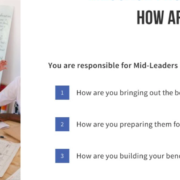Jeff Marquez recently authored this article on LinkedIn.
Do you have a jerk, bully, or slacker among you? Like weeds, you have to manage or prune away their behaviors. Chances are the face of a person is coming to mind. What feelings does this person evoke–stress, negativity, anxiety, or anger? Their toxic behavior is harmful to your Team. So how do you deal with difficult or toxic people? Step one is to determine the observable actions and behavior of such an individual and the effects on your organization. Then what?
My colleague and friend Chris Kolenda teamed up with executive coach, international best-selling author, and former FBI/police hostage negotiation trainer Mark Goulston, M.D., to share ways to deal with toxic behavior. It was pure gold.
Mark described a typical approach of a toxic person. They charm, frustrate, anger, and outrage you in that order. They use innuendos, and when you respond to it, they got you. Instead, look them in the eye and listen for a question. Then and only then do you respond. He says, “expect difficult people to be difficult, expect them to push or prod.” When they do, he advises holding a little bit of yourself back. They often do not have substance because they rely on provocation.
I have had the unfortunate experience of a toxic boss, and Mark described their behavior to a tee. Now, here you are in the throes of chaos, in the moment, face to face with the toxic one. What do you? Mark says pause and say to yourself, “opportunity for poise,” and do the following three steps:
1. Do not act on the first thought that comes to mind because it is your defense.
2. Do not act on the second thought that comes to mind because it is your attack or retaliation mode.
3. Act on the third because it is getting closer to solution mode.
I reflected on my experience and how I thought that the boss was just having a bad day. That day turned into weeks, then months. Toxic behavior can cause tremendous damage ranging from losing employees, decreased productivity, losing sleep, and impacts on family and loved ones. To prevent or minimize the damage, Mark offered the following ways to deal with a toxic or difficult boss, employee, or peer.
The Boss – If you have a difficult boss, use what Mark calls assertive humility. The tone is important, so a bit of emotion might be necessary.
1. Approach him or her with, “I need your help with something that is affecting my results. When would be a good time to talk?” He or she is likely geared toward results, so they will be curious.
2. At the time, find something positive, flatter them. “Do you know how smart you are in ______ (goal setting, vision…pick something they do well)?” They will become disarmed.
3. Tell them you are bringing that up because you do not want them to distract others from the potential that the specific skill or talent can bring to the organization. In other words, their toxic or difficult behavior is distracting and preventing employees from seeing the boss’s skills and talent.
4. If necessary, follow up with, “You have a little control of what you say and how you say it, but you have no control of how it is heard. I and others have observed that you are triggering flashbacks in people. Those flashbacks are not always positive like an angry parent, and they can be tough for people to work around. Try to trigger flashbacks that are positive and remind others of a positive parent, coach, or mentor.”
5. Finish it with, “You have no idea what kind of productivity you can get from people who, when you trigger them, either want to kill themselves or kill you. And you turn them into people who want to kill for you. It will blow your mind!”
Employee – If you have a difficult employee, again, use assertive humility with the appropriate tone.
1. Approach him or her with, “I need your help with something.”
2. Then say, “I’m really getting close to rooting against you, and it pains me. In fact, I do not want to work with anyone in this company I do not root for. The reason I’m getting close to rooting against you is because…” and tell them of the observed toxic or difficult behaviors.
3. Let them know that you do not believe that is the person they really are, that they are better than that. “Let’s consider this a wake-up call conversation that could lead to another one because if I get to a point where I am rooting against you, we will have to make changes.”
Peer – If you have a difficult peer or colleague, use assertive humility with tone.
1. Tell them, “I am getting really close to avoiding you. And I do not want to avoid you. It is bad for our Team and for our cooperation.”
2. Say, “The reason I am close to wanting to avoid you, why I am having this conversation is…” and tell them of the observed toxic or difficult behaviors.
3. Give them the benefit of the doubt. Let them know that you do not believe that is who they are or that something must be triggering them. “Instead of taking on the behavior of avoiding you, and I am not the only one, I am bringing it to your attention.”
Finally, Mark has a formula worthy of remembering: aggression + principle=conviction and aggression – principle=hostility. “Conviction makes you strong; hostility makes you wild.” If you have toxic or difficult people among you, manage or prune away the behavior. Let these tactics help you confront them, and get you back to focusing on your powerful Team and sustainable success.













